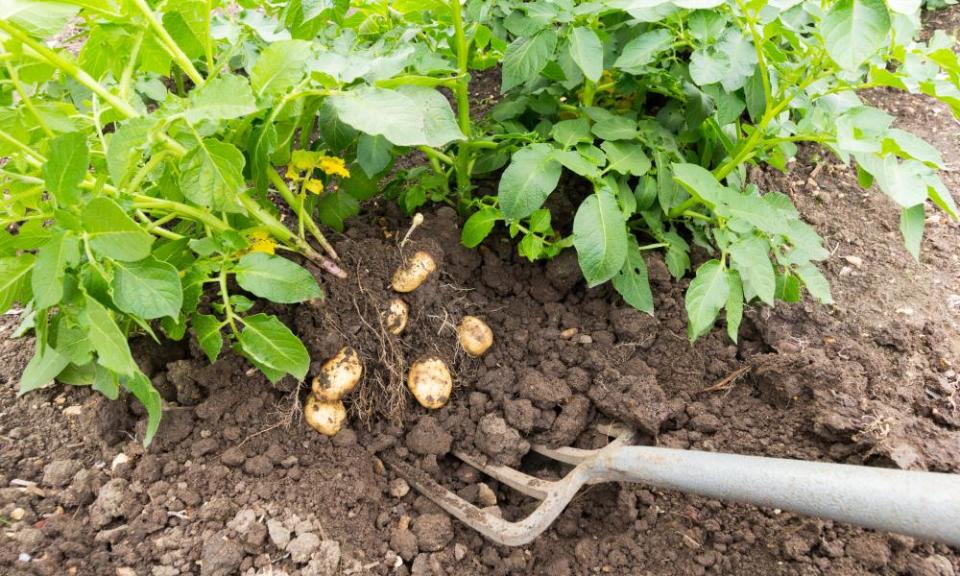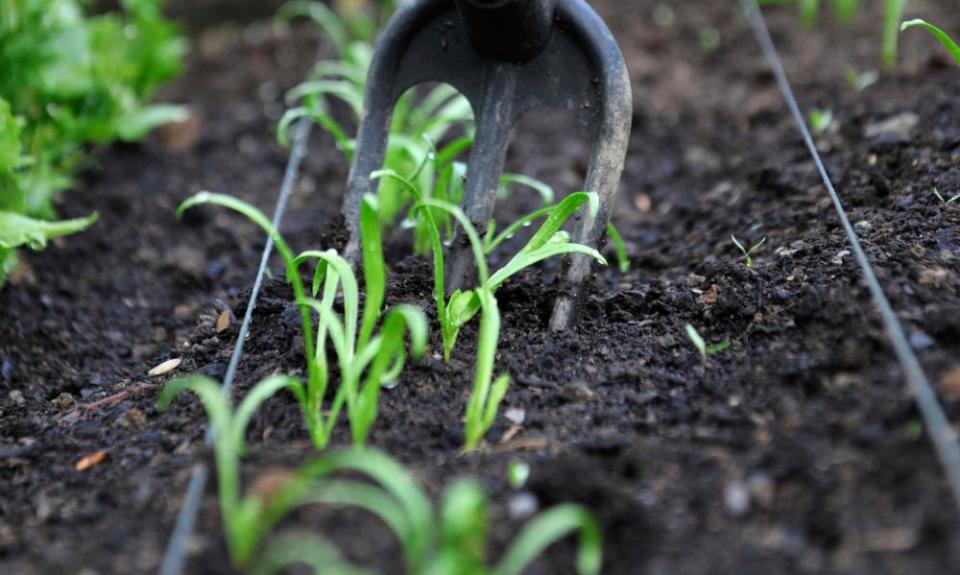Why climate-change gardening means breaking all the rules
Early in 2010, I moved from a home with a small, tidy back garden in Brighton to a wild smallholding more than 200 metres above sea level in Llandysul in Wales. Concerns about the climate crisis were at the heart of my move: I was living at sea level, near an underground river, and worried about flooding. But more than anything, I longed to live somewhere I could be self-sufficient.
After considering the options – Spain (extreme heat) and New Zealand (attractive but too far away) – I decided on Wales. Water shortages were unlikely, I thought, and property and land were affordable. So I left behind my old life to turn my passion for organic homegrown food into a full-time career – writing, running courses, making public speaking.
Gardening in this part of west Wales is very different from gardening in Brighton – the land is more suited to livestock than crops, and it has been a steep learning curve. No casual outdoor growing of tomatoes, aubergines, peppers and chillies in this cooler, wetter climate. No protection from the strong winds, no respite from the relentless rain (and, in 2018, a drought). And no fruit trees so high above sea level in a wind-ravaged spot, or so I was told. As a result, I had to adapt all my gardening techniques.
Today, I try to replicate the natural world where I can. I encourage weeds and local flora, let plants self-seed, and use wild areas for biodiversity (natural pest control) and protection against the elements. My approach is organic and sustainable, but ultimately it has evolved around a free-spirited instinct, and no following of rules.
My experiments have taught me that many traditional gardening practices no longer fit into our changing climate. They create scenarios in which you are fighting, rather than working with, the natural world and the resilience that can be found within it. By letting the natural world take the lead, I have created a garden that is healthier, more productive and lower-maintenance. Here’s how you can start to do the same.
Learn to connect

Machinery or tools can create a disconnect. My first spring in Wales I bought a rotavator to prepare my veg patch for planting, and watched in horror as it churned everything in its path, earthworms included. I now do my weeding by hand, avoid digging, and leave plant roots in the ground so as not to disturb the soil and microbial activity within.
That said, do what feels right. I plant and dig out potatoes, jerusalem artichokes and ocas by hand because it’s fun and they grow better that way for me.
Try not to use gloves. Stick your fingers in the soil to see if a plant needs water or not. Look, smell and feel your way. Touching soil is good for your own gut microbiome – research by Bristol University and University College London in 2007 (published in Neuroscience) suggested that coming into contact with soil bacteria (Mycobacterium vaccae) can stimulate the release of serotonin, which is a natural antidepressant and makes you feel better overall.
Connect with your local community and neighbours, to barter and share produce, seeds, materials and ideas. Join gardening groups, organic and permaculture associations, even local Facebook groups. Your nearest garden centre can be a mine of useful information.
Break rules
Question perceived wisdom, and try to think independently. For example, out-of-date seed can often still be germinated, it just needs planting more thickly. Leave plants in the ground for as long as you can. Brassicas such as chard, flat-leaf kale and purple spouting broccoli can be successfully grown on for many years, saving you time, effort and money.
I don’t use fertiliser for hungry Mediterranean fruits like tomatoes (which I grow in a polytunnel) because it makes them needy for more, and stops their roots seeking out natural resilience through symbiotic relationships with underground fungi. Instead make your own compost from leaf mould, and boost it with comfrey, nettles, seaweed, chicken poo and borage.

Learn from your mistakes
When my neat, long row of tomato plants succumbed to blight, I realised that having plants so close together was making it easier for this airborne fungus to spread. Now, with mixed planting, and at more than a metre between similar plants, I don’t have blight, pests or disease. I don’t have to use crop rotation now either.
Spend less and get creative
Try to work with what you already have. I have turned old windows into a makeshift cold frame, and created planters out of rubbish – from old pallets and wellies to battered Belfast sinks and a neighbour’s tractor tyres (to house comfrey plants). Repair and maintain your tools.
Save seed and grow on supermarket leftovers: citrus pips can be grown into houseplants – they will be hybrids but still may eventually bear fruit. Lime leaves can be used in cooking in the interim. Organic ginger and turmeric stems can produce a viable harvest: choose a golfball-sized piece with an eye – the nobbly, protruding bit – and place in a plastic zip bag in your warmest spot. Plant out when the eye goes green and starts trying to shoot up. Plum, apricot and avocado stones can be germinated in compost in spring (don’t expect homegrown avocados, but they make attractive houseplants). Dried peas can be soaked in water and turned into salad sprouts or planted in pots for pick-and-come-again pea shoots over winter.

Grow what works best for your space
Stop trying to grow high-maintenance plants that don’t naturally flourish in your location and soil type. Look at easier, more resilient alternatives.
Avoid anything with exacting watering requirements (for example, sprouts or cauliflower); instead, grow pick-and-come-again leaves such as spinach, chard and kale. For ease of growing, I also favour purple sprouting broccoli over the ordinary kind.
I can’t grow tomatoes outside, but I can grow tomatillos, which are very hardy once established. After almost running out of water entirely in the 2018 drought, I rooted the stems of tomatoes in polytunnels to reduce their water requirements (they feed from two places or more, rather than one). Likewise, crystal lemon cucumber flourishes – no matter the weather.
Protect your plants naturally
I was told that I couldn’t grow fruit trees so high up, which immediately made me determined to do so. I found that planting a row of quicker-growing damson trees slowed the strong winds sufficiently for my apple and pear trees to establish and grow after just two years.
Protect your soil all year round with ground cover. In summer, fill any bare patches with plants to help protect against the drying glare of the sun, and to minimise watering. Quick-growing lettuce, herbs and edible flowers like nasturtium, as well as pumpkin and squash, with their large leaves, can be trailed around plants to shelter the ground.
Over winter, soil fertility can leach away with lots of rain, so help bind it together with green manures, perennial plants and spent crops left to rot naturally. Mulches and covers also protect against erosion.

Favour natural pest control
Seed heads, piles of leaf litter, dead branches or stinging nettles all provide a winter haven for beneficial predators such as frogs, toads, newts, ground beetles, hedgehogs, solitary bees, ladybirds and lacewings – as well as providing food for birds.
Embrace free planting (polyculture) as our medieval ancestors did – mixing crops together makes it harder for pests to proliferate, and you will have more natural biodiversity. Try companion planting: for example, place strong-smelling plants such as onions or marigolds around carrots to disguise the smell of the foliage and deter carrot fly.
Go wild
Look to the past and heritage varieties (try Garden Organic’s Heritage Seed Library) for a wide variety of plants saved from extinction. They may offer greater resilience against our changing climate than the smaller pool of modern varieties commonly available. Wild fruit trees, such as plum and crab apple, can grow in the most extreme circumstances, and tend to adapt more readily to local conditions. The Woodland Trust offers a nice range.

 Yahoo Finance
Yahoo Finance 